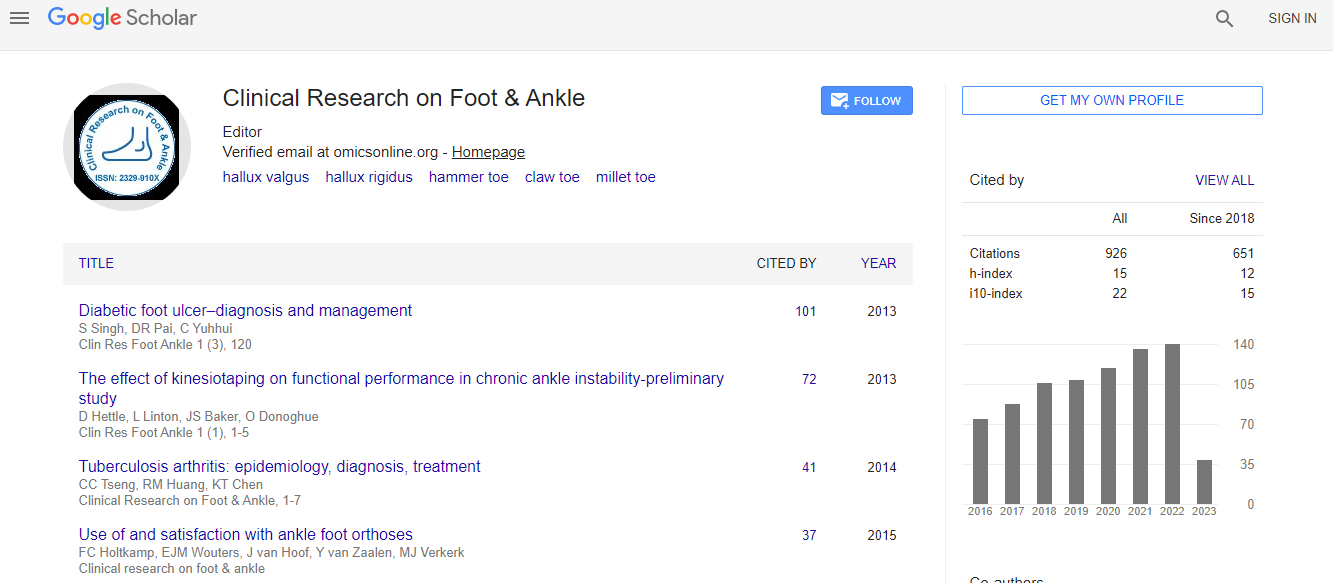Research Article
Treatment of Osteoid Osteomas of the Foot: A Review of 100 Cases
| Andrea Angelini, Giulia Trovarelli, Todd Bertrand, Marco Maraldi, Bassem Issam Haddad, Ilaria Piraino and Pietro Ruggieri* | ||
| Department of Orthopedics, University of Bologna, Istituto Ortopedico Rizzoli, Bologna, Italy | ||
| Corresponding Author : | Prof. Pietro Ruggieri Department of Orthopaedics University of Bologna, Orthopaedic Oncology Rizzoli Orthopaedic Institute, Via Pupilli 1, 40136, Bologna, Italy Tel: 00390516366222, 00393333266234 Fax: 00390516366540 E-mail: pietro.ruggieri@ior.it |
|
| Received August 25, 2014; Accepted September 25, 2014; Published October 03, 2014 | ||
| Citation: Angelini A, Trovarelli G, Bertrand T, Maraldi M, Haddad BI, et al. (2014) Treatment of Osteoid Osteomas of the Foot: A Review of 100 Cases. Clin Res Foot Ankle 2:154. doi:10.4172/2329-910X.1000154 | ||
| Copyright: © 2014 Angelini A, et al. This is an open-access article distributed under the terms of the Creative Commons Attribution License, which permits unrestricted use, distribution, and reproduction in any medium, provided the original author and source are credited. | ||
Related article at Pubmed Pubmed  Scholar Google Scholar Google |
||
Abstract
Objectives: Osteoid osteoma (OO) is a small, benign, osteogenic bone tumor, with less than 11% of cases located in the feet. We review our experience in OO of the foot bones in order to characterize its prevalence, treatment, and recurrence rate at long term follow up.
Methods: The medical records of 100 cases of osteoid osteoma of the foot treated between 1975 and 2009 were reviewed retrospectively. There were 73 male and 27 female patients, with a mean age of 23.4 years (7-61 years). The lesions were located in the talus (n=59), calcaneus (n=14), metatarsal bones (n=9), cuneiform bones (n=5), phalanges (n=4), cuboid (n=4), navicular (n=2) and tarsal bones, not otherwise specified (n=3). None of the patients had received prior percutaneous or surgical treatment for the tumor. Twelve tumors were intra-articular and 88 extraarticular. All patients were taking routine analgesics including anti-inflammatory medications.
Results: Treatment consisted of radiofrequency ablation (RFA) in 43 patients, excisional CT-guided trocar biopsy, or percutaneous drill resection (PDR) in 21 patients, intra-lesional curettage in 43 patients, and wide resection alone as well as wide resection with total ankle arthroplasty in one patient each. Adequate follow-up was available for all patients. One patient treated with RFA reported recurrent pain after 2 months and was successfully treated with a second RFA. The overall recurrence rate was 1%; however, it was 2.3% in those patients treated with RFA. No adverse events related to treatment or to the anatomical location were recorded.
Conclusion: RFA is a safe and effective alternative to surgical resection of osteoid osteomas of the foot. Caution should be taken when performing this procedure on lesions less than 1 cm from neurovascular structures or in superficial locations, due to risk for soft tissue injury from thermal necrosis.

 Spanish
Spanish  Chinese
Chinese  Russian
Russian  German
German  French
French  Japanese
Japanese  Portuguese
Portuguese  Hindi
Hindi 
